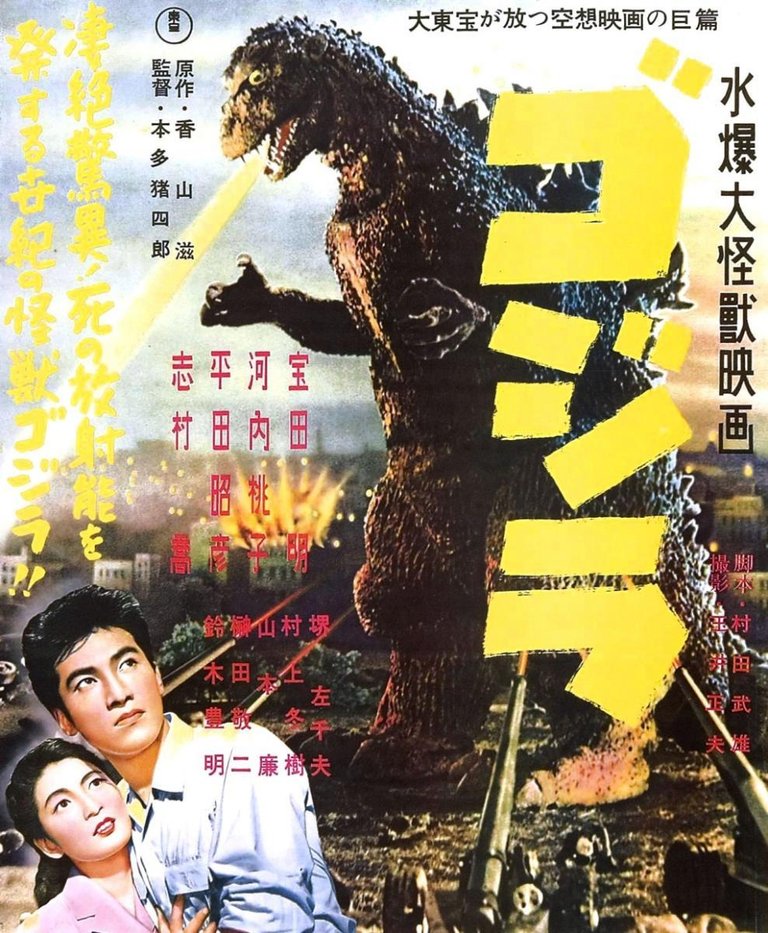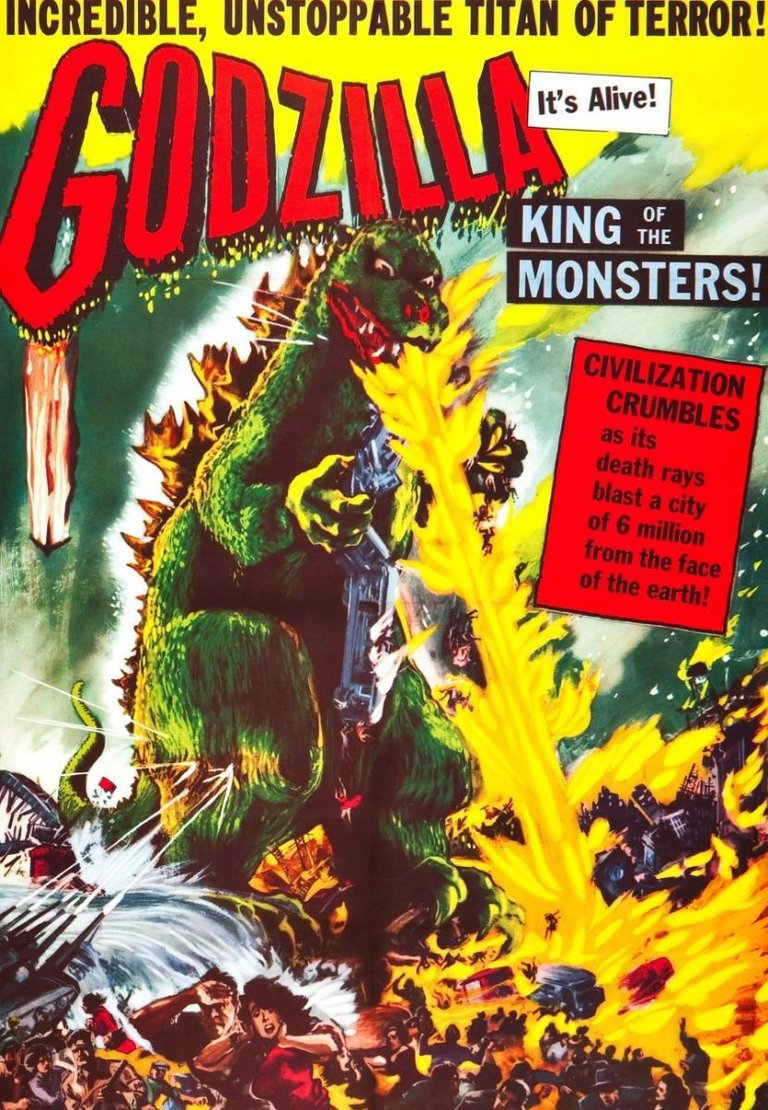Todos hemos visto películas donde el enemigo o protagonista es alguna clase de monstruo gigante de aspecto muy intimidante, como este año se estrenó Godzilla x Kong decidí contar un poco de cómo fue originándose este tipo de películas en el cine y como han sido una fuente de fascinación para los fanáticos de estás producciones.
La palabra Kaijus tiene sus raíces en el japonés, que traducido al español significa bestia gigante, son una parte importante del folklore japonés, descritos como seres de tamaño descomunal capaces de arrasar ciudades muy fácilmente. El término Kaiju gano fama gracias al cine de Japón, gracias al género de películas Kaiju eiga o películas de monstruos gigantes.

Fuente/Source
Aunque siempre se asocia a los monstruos gigantes con Japón, en todas las culturas siempre se han mencionado seres de gran tamaño viviendo en las profundidades como el Leviatán de los hebreos o la serpiente de Midgar de los nórdicos, fueron la inspiración para estas historias.
En algunos casos se llegó a pensar que nuestro mundo surgió a partir de los restos de un Kaiju, algunos no los llaman monstruos sino eventos de la naturaleza que no eran malvadas o buenas, sino parte del equilibrio natural.
Puede que la razón por la que aún nos llama la atención estas historias es porque aún sabemos muy poco de las profundidades del océano, siendo fuente de inspiración para leyendas como el Kraken, un gigantesco calamar que destruía navíos y que sería la base para Cthulhu o el propio Godzilla.

Fuente/Source
A pesar de que la ciencia demuestra que estos seres no existen nos encanta imaginar que existen rondando por ahí durmiendo bajo un volcán, dentro de algún asteroide o esperando llegar desde otra dimensión.
Este es un género más que todo visual, ya sea en cómics, manga, videojuegos, películas o series animadas o live action, pero un escritor habilidoso puede transmitir la complejidad de estas criaturas como H.P Lovecraft.
Este género de películas emergió a partir de 1950 en Japón, debido a las marcas que dejo la Segunda Guerra Mundial, la bomba atómica en Hiroshima y Nagasaki, y la ocupación hecha por los estadounidenses.

Fuente/Source
El estudio TOHO fue el encargado de diseñar a Godzilla, siendo la cinta que popularizó a los Kaiju. Estrenándose en 1954 nos presentan a la criatura como un ser radioactivo que energía desde el mar para sumir a Tokio en el caos y destrucción. Además de ser un éxito comercial, dio lugar a una gran cantidad de secuelas y spin-off.
Siempre vemos a los Kaiju como seres que buscan destrucción, pero también son usados como metáforas del poder de la naturaleza, problemas sociopolíticos, etc. Cómo el Godzilla de 1954 que es una forma de representar las secuelas que dejo la guerra, también exitos como Pacífico Rim de 2013 o Neon Génesis Evangelion de 1995 han llevado mucho más lejos esta narrativa, con una gran variedad de temas mucho más complejos y argumentos muy bien desarrollados.
Ya sean seres destructivos, peleando con otros Kaiju o enfrentando invasiones alienígenas, estos seres siempre nos han sorprendido.
English Version
We have all seen movies where the enemy or protagonist is some kind of giant monster of very intimidating aspect, as this year Godzilla x Kong was released I decided to tell a little of how this kind of movies originated in the cinema and how they have been a source of fascination for the fans of these productions.
The word Kaijus has its roots in Japanese, which translated into English means giant beast, are an important part of Japanese folklore, described as beings of enormous size capable of razing cities very easily. The term Kaiju gained fame thanks to Japanese cinema, thanks to the genre of Kaiju eiga or giant monster movies.

Fuente/Source
Although giant monsters are always associated with Japan, all cultures have always mentioned beings of great size living in the depths as the Leviathan of the Hebrews or the Midgar snake of the Norse, were the inspiration for these stories.
In some cases it was thought that our world emerged from the remains of a Kaiju, some do not call them monsters but events of nature that were not evil or good, but part of the natural balance.
Maybe the reason why these stories still attract our attention is because we still know very little about the depths of the ocean, being a source of inspiration for legends such as the Kraken, a gigantic squid that destroyed ships and that would be the basis for Cthulhu or Godzilla himself.

Fuente/Source
Even though science proves that these beings do not exist, we love to imagine them roaming around sleeping under a volcano, inside an asteroid or waiting to arrive from another dimension.
This is a mostly visual genre, whether in comics, manga, video games, movies or animated series or live action, but a skilled writer can convey the complexity of these creatures like H.P. Lovecraft.
This film genre emerged from 1950 in Japan, due to the marks left by World War II, the atomic bomb in Hiroshima and Nagasaki, and the occupation by the Americans.

Fuente/Source
The TOHO studio was in charge of designing Godzilla, being the film that popularized the Kaiju. Released in 1954, the creature is presented as a radioactive being that comes from the sea to plunge Tokyo into chaos and destruction. In addition to being a commercial success, it gave rise to a large number of sequels and spin-offs.
We always see Kaiju as beings that seek destruction, but they are also used as metaphors for the power of nature, sociopolitical problems, etc. Like 1954's Godzilla, which is a way of representing the aftermath of the war, also blockbusters like 2013's Pacific Rim or 1995's Neon Genesis Evangelion have taken this narrative much further, with a variety of much more complex themes and well-developed plots.
Whether they are destructive beings, fighting with other Kaiju or facing alien invasions, these beings have always surprised us.
¡Muchas gracias por tomarte el tiempo de leerme!
Thank you so much for taking the time to read me!
Traducido con DeepL / Translated with DeepL
Congratulations @favilan! You have completed the following achievement on the Hive blockchain And have been rewarded with New badge(s)
Your next target is to reach 200 comments.
You can view your badges on your board and compare yourself to others in the Ranking
If you no longer want to receive notifications, reply to this comment with the word
STOP